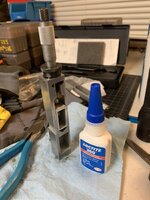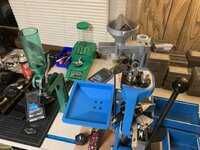- Joined
- Oct 22, 2014
- Messages
- 13,933
Ha! Just today realized it was a rabbit hole you hadn’t chased.
Listen. You are supposed to know what I need at all times and inform me thusly.
Don’t let it happen again sir.
Follow along with the video below to see how to install our site as a web app on your home screen.
Note: This feature may not be available in some browsers.
Ha! Just today realized it was a rabbit hole you hadn’t chased.
Have you tested the Lee thrower at all? I realize the adjustability wouldn't be as slick as the Harrell, but I'f it throws consistent weights I'd probably give it a try.I bet you could get some loading done on that, but I probably won't be switching in that direction personally.
The fancy scale is nice for testing, and I'm also convinced it can shrink vertical at distance some if you're being picky. It certainly isn't necessary, but I like nice tools and only have 1.3 hobbies.
Listen. You are supposed to know what I need at all times and inform me thusly.
Don’t let it happen again sir.
Have you tested the Lee thrower at all? I realize the adjustability wouldn't be as slick as the Harrell, but I'f it throws consistent weights I'd probably give it a try.
@FlyjunkyThe results of the 5 different seating depth rounds. From 2.662” to 2.765” COAL.
.66 MOA
View attachment 615367
The only Lee I’ve “used” is the one that is part of the AutoTrickler, so that’s a pretty different experience. What I’ve heard is that the design doesn’t really bind even with big extruded powders, which is why Adam picked it for the AutoTrickler. I see no great repeatable adjustment available for it (though I haven’t gone looking) which really would change the use case for me. If I was really tight on funds but loading hundreds of the same load at a time (two statements that really don’t go together) I could see fiddling with it enough to get it dialed in but that’s trying pretty hard to find a situation where it might make sense.
For a regular thrower with a mostly unmarked screw for an adjustment, I feel similar to what Form initially expressed, you aren’t likely to have a good experience.
I’ll bet that would change depending on bullet and chamber design as well. Older, sloppier chambers would probably be more finicky and then add in short bearing surface/long ogive bullets. Like Miles said, a big key to accuracy was how straight the bullet entered the lands. Add in the factors I mentioned above and it comes down to many variables where blanket statements can’t be made.
I’ll bet that would change depending on bullet and chamber design as well. Older, sloppier chambers would probably be more finicky and then add in short bearing surface/long ogive bullets. Like Miles said, a big key to accuracy was how straight the bullet entered the lands. Add in the factors I mentioned above and it comes down to many variables where blanket statements can’t be made.
Regardless, .66 MOA is not a small amount.
I am sure your test is showing what you’re intending. I have bought in to your theories on cone of rifle and 10 shot minimum after seeing results.The results of the 5 different seating depth rounds. From 2.662” to 2.765” COAL.
.66 MOA
View attachment 615367
I am sure your test is showing what you’re intending. I have bought in to your theories on cone of rifle and 10 shot minimum after seeing results.
As it relates to come size and number of shots for significance does that matter here? Would one shot at a depth need 9 more to compare against the baseline group size seating depth? And the other 4 depths needing the same?
I am not intending to come across overly technical here. Just trying to piece together how this all works.
Thanks!
My bad, I thought it was saying between 2.662 - 2.765 there was a .66 difference.The issue is that no one has proven it, or been able to prove it with statistical sample sizes, and proven the difference repeatable. Only those people who haven’t done blind 20+ shot groups say that seating depth in general makes any legitimate difference. Everyone that has tried has come to the same conclusion- relatively small changes- including seating depth has little to no legitimate effect on true precision. Only in small sample sizes for sit appear that way, and it can not be repeated.
.66 MOA is a large group?
So if brass, primer and seating depth don’t matter what does?
Powder, bullet and barrel?
So if brass, primer and seating depth don’t matter what does?
Powder, bullet and barrel?
I am sure your test is showing what you’re intending. I have bought in to your theories on cone of rifle and 10 shot minimum after seeing results.
As it relates to come size and number of shots for significance does that matter here? Would one shot at a depth need 9 more to compare against the baseline group size seating depth? And the other 4 depths needing the same?
I am not intending to come across overly technical here. Just trying to piece together how this all works.
Thanks!
So if brass, primer and seating depth don’t matter what does?
Powder, bullet and barrel?
Thank youCorrect. If a bullet and powder combination does not shoot a 10+ round group that is satisfactory to you, change bullet or powder. If two powders don’t shoot with a certain bullet, you have to change bullets. If two different bullets don’t shoot with a certain powder, changer powder.
If you don’t find a combination with two different bullets and two different powders- change barrels.



Is that because it can’t be made to shoot better, or because it’s a waste of time?Correct. If a bullet and powder combination does not shoot a 10+ round group that is satisfactory to you, change bullet or powder. If two powders don’t shoot with a certain bullet, you have to change bullets. If two different bullets don’t shoot with a certain powder, changer powder.
If you don’t find a combination with two different bullets and two different powders- change barrels.
Is that because it can’t be made to shoot better, or because it’s a waste of time?
That could be a bitter pill to swallow, especially if you bought a barrel from a company you’d expect a good barrel from.
I’m relatively new to reloading, and I was determined that my reloading techniques were the problem with a gun I had last year. But I was determined that I was the problem because the gun was expensive and changing the barrel didn’t make sense. I’ll have to say that no combination of bullets, powders, primers, brass or seating depths ever made it much better, though some were certainly worse.
